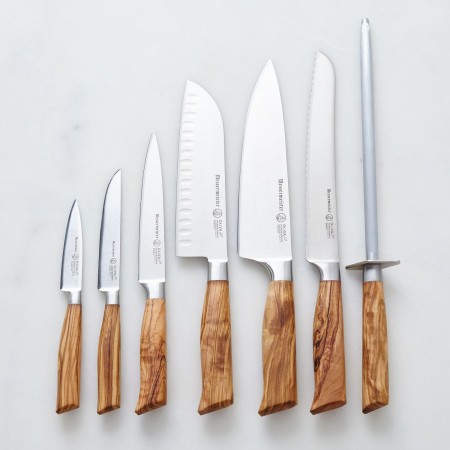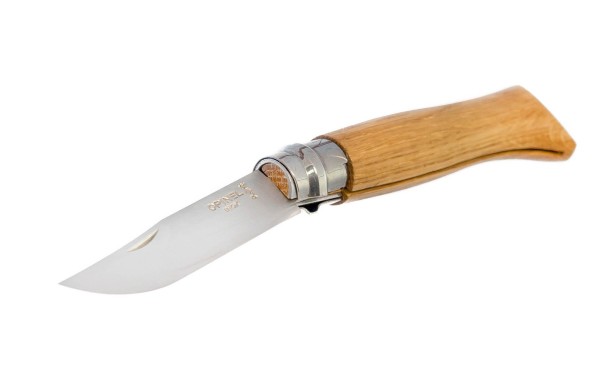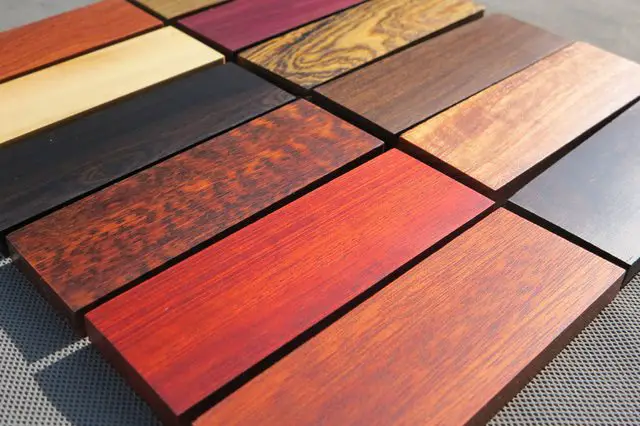When people think about what kind of knife to get for their kitchen, they don’t often immediately think of the handle. They usually focus on the blade and shape of the knife, but in reality, the handle of the knife is just as important as the blade.
If you’re an avid cook, you know that having a blade that rests comfortably and naturally in your hand is vital to a happy chef in the kitchen.
Today, we’re going to take a deep look at wooden knife handles. Wood has been used as a knife handle material ever since the birth of the knife, and for good reason. But with literally thousands of wood types that exist in the world, you’ve probably wondered what the best woods for knife handles are.
By the end of this article, you’ll be convinced that your next knife will have a wooden handle. The only question will be which material to get.
Why Use Wooden Knife Handles?
Knife handles can be made out of a variety of materials, including metal, plastic, stag, and even bones, but each of these has negative aspects. Plastic handles, for instance, are not very durable. Metal handles, on the other hand, are quite durable, but very heavy and often do not balance well with the blade.
Wooden knife handles have been used around the world since the beginning of time because of their perfect combination of durability, beauty, and practicality.
Durability
While some woods are susceptible to water, wooden handles that are maintained correctly will last you a lifetime. Depending on the type of wood you choose, they can last you even longer than metal handles with proper care. A good example of such wood varieties would be African Blackwood. Thanks to their high density and durability, you’ll often find them in metal-working tools.
Ease of Usage
Wood is an organic substance that feels natural and fits comfortably in your hand. This handle material is warm to the touch and often has a textured grip that really feels better than any other kind of material in your hand as a knife handle.
Aesthetics
This one’s obvious. Imagine a knife blade with a wooden handle…then think of one with a plastic or metal handle. Which one looks better?
There is a massive variety of different woods that provide different colors, grains, and designs that come from the greatest artist that exists – mother nature. Wooden knives have a ton of character that holds value over time. Depending on the type of wood, a skilled woodworker will be able to carve intricate designs into the handle as well.
Affordability
Again, it depends on the type of wood, but compared to other materials, wood is much more affordable and is generally more inexpensive than other materials such as steel. This isn’t to say that wood is not as good quality – it is just much more accessible and easy to find material than other materials.
Best Wood For Knife Handles
Now that we’ve covered why wood is superior to other materials used for knife handles, it’s time to jump into the fascinating world of different types of woods. There are thousands of different types of wood, all of which have their own traits and qualities that either make them perfect or unsuitable for knife handles.
The first thing to remember is that there is no one “best” wood. Every person has their own desires and needs when it comes to their knives, so you need to think about what works best for you and your style and go from there.
1. Olive Wood

Olive wood originates from Kenya, Tanzania, Uganda and the Mediterranean. The Olive wood generally is a pale brown or yellow with beautiful darker brown or black streaks with a fine and even texture. The color is known to darken with age, giving it a lot of character. The material is very dense, making it resistant to abrasion. On the downside, Olive is known to be prone to insect infestation, but this can be avoided with careful maintenance.
Although it is often used for furniture, sculpture, and veneers, it is also very attractive for fine knife handles.
2. Oak

Oak is an extremely popular choice of wood for knife handles, and it’s easy to see why. There are over 60 species of oak that grow in the United States alone. Because of this, the oak handle is affordable. It is very beautiful and takes staining very well. The oak wood is also moderately strong and stable. On top of that, oak is extremely easy to work with, so knifemakers can often add carvings and inscriptions to the handle after it is finished.
Because of its rare combination of affordable price and strong composition, it is a very popular option for kitchen and hunting knives, as well as other specialty items.
3. Walnut
Walnut wood refers to the American Black Walnut Tree. Although it is one of the most valuable hardwoods that originates from North America and is used in everything from guns to furniture to veneers to instruments, it is not the best wood to use for knives.
It has a very soft, open grain that can be easily damaged with constant use. There are much more durable woods on the market.
Its dark brown color is very elegant and beautiful which makes it quite desirable to some people. My suggestion would be to only use walnut for your knife handle if you plan on only using that knife sporadically.
4. Rosewood
Similar to oak wood, rosewood is very cost-effective. The color can vary in shade, from a light golden brown to a darker purple. Rosewood also darkens with age, giving it a beautiful, luxurious character after polishing.
Rosewood is quite sturdy and is perfect for knives that have demanding use, such as kitchen knives or skinning knives.
Indian Rosewood is even known to resist all types of contaminants, including termites!
5. Birch Laminate
Birch is one of the most common woods around the world and is very environmentally friendly. Birch trees grow very quickly and require very little maintenance.
Birch laminate is a manmade wood product that is created by infusing dyes and chemicals that are vacuum impregnated into the birch wood, then compressed with very high pressures. This high compression creates a super dense and strong wood that is very durable and polished brightly. Pakkawood, Dymondwood, etc. go through similar production process.
The colors are bright and showy, and can even look a bit unnatural in certain patterns.
6. Ebony
Ebony wood is a very exotic wood that originates from Africa. The heartwood is completely black and has a very straight grain with a smooth lustrous finish.
It is very stable, high in strength and can be brightly polished. Although it is expensive, it is very beautiful and luxurious and is in demand for everything from door knobs to billiard cues to piano and organ keys.
This one’s my personal favorite. Ebony wood’s unique dark hue stands out amongst the rest and holds its value very well over its lifetime.
7. Amboyna
Amboyna wood is often touted as one of the world’s most expensive woods but is still readily available almost everywhere. Its name comes from the island of Amboyna in Indonesia. Amboyna is a uniquely beautiful wood that has a great variety in its appearance.
Although it is quite expensive, anyone who gets it knows it’s worth the money. Along with its beauty, it is very solid, stable, and resists oxidation well.
Even though it’s strong enough to be used as an everyday knife or even a hunting knife, it is probably more suitable as a collectible artisan knife because of its price tag.
8. Bloodwood
Bloodwood is an easily recognizable wood that originates from South America. Like its name might suggest, it is a beautiful, bright blood red.
It is moderately hard but very durable and long-lasting. It is good for making knife handles, stands, knife sheaths, and ornamental woodwork.
9. Cocobolo
If you’ve ever done any research about woods for knife handles, you’ve probably come across Cocobolo wood at some point. This extremely stable wood is one of the most popular materials for handmade custom knife handles. It originates from the pacific seaboard of Central America.
It is a very dense, stable, oily, and resinous hardwood, which contributes to its reputation for dependability. When first cut, Cocobolo has a very rich, striking pattern of color with red, brown, tan, orange, and yellow all exhibited. After a year or two, the colors darken, sometimes almost all the way to black. Cocobolo lasts a long time, no matter how much you use the wood handle, making it perfectly suitable for your everyday kitchen knife or hunting knife.
10. Bocote
Bocote originates from Mexico, Central, and South America. It has a medium density and is very porous, which can sometimes be a problem when finishing. It needs to be sealed very carefully to keep it from absorbing swarf, polish, and metal.
If finished well, Bocote makes for a very beautiful and long lasting handle. It features a light tan background with dark brown stripes that swirl.
11. Desert Ironwood
Desert Ironwood is an extremely expensive wood. It is one of the hardest and most stable woods known to man. It features a range of colors, from a brighter yellow to orange to a darker red or brown. Because of its weight, it is popularly used to counterbalance longer blades.
12. Koa Wood
Koa wood is a very expensive and beautiful wood that only grows on the islands of Hawaii. It features a brighter yellow and gold to darker red and brown. It is a relatively easy wood to work with and is very strong and durable, making it well-suited for knife handles.
Read also: Best Knife For Wood Carving
Things to Keep in Mind
1. Wooden Knife Handles Require Maintenance
Like I stated earlier, wooden knife handles can be extremely durable and long-lasting as long as they are maintained carefully. It is important to maintain a wooden handle correctly because wood can dry out, even if you aren’t using it. Depending on the type of wood, some may dry out faster than others.
To keep your wooden knife handle hydrated, it is important to give it a couple drops of oil every once in a while. Not only will this keep your knife handle well hydrated and protect it against weather changes, but your knife will look much more beautiful as well.
2. Cheap Wood May Rot
If you do not carefully maintain your wooden knife handle, it is susceptible to rotting. Cheap wood is especially susceptible to rotting.
This means that fungi may grow from the accumulation of moisture and changing temperatures, leading to the wood disintegrating. Keep this in mind when making your final decision on what kind of wood to get for your knife handle.
Hardwood vs Softwood? What About Stabilized Wood?
Simply put, hardwoods refer to deciduous trees that bear flowers and have broad leaves, while softwoods refer to coniferous trees that have needles.
Like the names state, most hardwoods are more physically dense and more resistant to penetration, while softwoods are typically not as dense. Although there are exceptions to this, almost all knife handles are made from hardwoods.
Stabilized woods, on the other hand, are woods that are dried and infused with chemicals to stabilize them. Although manmade, they are extremely tough and long-lasting after being subjected to the high-pressure process of stabilization.
What Is The Best Finish For a Wooden Knife Handle?
No finish is the best finish.
Woods are naturally hard. They can use a good polish and oiling or waxing every once in a while, but won’t need a finish. A glossy finish on your kitchen knife may make it a bit slippery, which is obviously very dangerous and should not be used on the kitchen knife.
Is Hickory Good For Knife Handles?
Although hickory is okay to use in certain cases for your knife handles, it has a very open grain and can collect a ton of dirt and debris from your hands, so it takes a lot of skill to finish it right. You may need to use extra oils to fill the pores if you want to use hickory.
How Do You Treat Wooden Knife Handles?
Adding a few drops of oil and applying with a clean towel is the best way to treat your wooden knife handles. As stated earlier, wood is susceptible to drying out whether you use them or not, so it is important to treat them regularly to keep them hydrated and to avoid cracking.
Is Mahogany Good For Knife Handles?
Mahogany is good for things like furniture, but in my opinion, it is quite plain and not that impressive. In addition, it is quite light compared to other woods, so the feel of the knife in your hand can feel awkward. I wouldn’t recommend mahogany for your knife handle.
Is Cedar Good For AXE Handles?
Cedar is not a traditionally used wood for axe or knife handles because it is really soft. I would avoid using it as it is not strong and is too light as well.
Is Cherry Wood Good For Knife Handles?
Cherry wood makes a great knife handle. It isn’t the most beautiful or impressive, but it is very durable and can make a great knife handle.
Conclusion
Today, we covered a ton about wooden handles and the different kinds of materials that come along with it, but to be honest – there’s a lot more out there! Hopefully, this article was a helpful jumping off point to see why wood is still one of the most popular choices for knife handles today.
Remember to choose a wood that fits your style, aesthetics, and use. After that, your only limit is your imagination!
Go find your perfect wood for your next knife.

